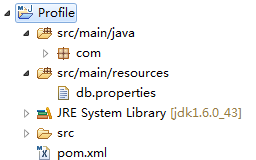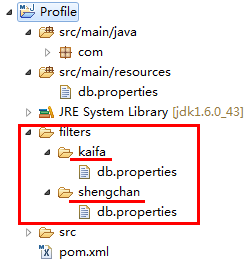Maven插件之portable-config-maven-plugin(不同环境打包)
大的项目组中,分开发环境,测试环境,生产环境等;不同环境的配置不同,或数据源,或服务器,或数据库等;
问题来了,如何使用Maven针对不同的环境来打包呢?
Maven提供了Profile的概念,用来解决此类问题,其原理很简单,就是使用变量替换;举个例子来说明,测试项目目录结构如下图所示:
比如开发环境和生产环境的数据库不同,db.properties配置文件内容如下:
- #测试库
- db.url=192.10.2.168
- db.username=dbtest
- db.password=dbtest
- #正式库
- #db.url=192.20.1.11
- #db.username=admin
- #db.password=comfreesecurity
默认开启测试环境;生产环境打包时,需要手动修改该配置文件. juvenxu说过,手动意味着低效率,高错误率!!
Maven提供的Profile功能,可解决以上问题:
1、在pom.xml文件中定义两个不同的Profile,分别定义开发环境和生产环境的数据库信息:
- <profiles>
- <profile>
- <id>kaifaid>
- <properties>
- <db.url>192.10.2.168db.url>
- <db.username>dbtestdb.username>
- <db.password>dbtestdb.password>
- properties>
- profile>
- <profile>
- <id>shengchanid>
- <properties>
- <db.url>192.20.1.11db.url>
- <db.username>admindb.username>
- <db.password>comfreesecuritydb.password>
- properties>
- profile>
- profiles>
2、将原来的配置文件内容修改如下:
- db.url=${db.url}
- db.username=${db.username}
- db.password=${db.password}
3、需要 开启资源文件过滤 ,代码如下:
- <resources>
- <resource>
- <directory>${project.basedir}/src/main/resourcesdirectory>
- <filtering>truefiltering>
- resource>
- resources>
添加
4、使用Maven命令打包时,指定Profile进行打包,命令如下:
mvn package -Pkaifa
mvn package -Pshengchan
如此即可。
此命令用的多了,就会发现,两个环境必选其一,如果能设置其一个为默认开启,就不用每次都手动指定了,这个需求很现实,毕竟开发环境需要持续不断的编译、打包、部署等,而上线,则是一段时间才会运行一次的;因此,默认启用开发环境是最优的方案,Maven支持默认启用某个Profile,只需在
- <activation>
- <activeByDefault>trueactiveByDefault>
- activation>
此处需要注意:一旦显式指定某个Profile,则该配置无效!
在实际开发中使用以上方式操作时,自然而然的会提出以下的问题:假如配置文件的信息很多,那么Profile的内容会很臃肿,不便于管理,如果能将配置信息从Profile抽取出来,独立放置,再根据不同的Profile去调用,如此就更好了!
Maven针对以上需求,确实有解决方案,就是使用
项目根目录下新建如下目录和文件:
db.properties问标准的属性文件,kaifa/db.properties和shengchan/db.properties文件内容分别如下:
- db.url=192.10.2.168
- db.username=dbtest
- db.password=dbtest
- db.url=192.20.1.11
- db.username=admin
- db.password=confreesecurity
将Profile中的属性信息抽取到了db.properties文件中,同时在Profile中添加
- <profiles>
- <profile>
- <id>kaifaid>
- <activation>
- <activeByDefault>trueactiveByDefault>
- activation>
- <build>
- <filters>
- <filter>${basedir}/filters/kaifa/db.propertiesfilter>
- filters>
- build>
- profile>
- <profile>
- <id>shengchanid>
- <build>
- <filters>
- <filter>${basedir}/filters/shengchan/db.propertiesfilter>
- filters>
- build>
- profile>
- profiles>
添加了
如此之后,使用Maven命令进行构建即可。
细心的人会发现,以上Profile中的filters部分,除了使用的目录名称不同之外,其他代码全部相同,重复!!!如果再多几个环境的话,代码冗余可想而知,因此需要优化,其实方法很简单,还是使用变量替换,修改后的pom.xml文件内容如下:
- <project xmlns="http://maven.apache.org/POM/4.0.0" xmlns:xsi="http://www.w3.org/2001/XMLSchema-instance"
- xsi:schemaLocation="http://maven.apache.org/POM/4.0.0 http://maven.apache.org/xsd/maven-4.0.0.xsd">
- <modelVersion>4.0.0modelVersion>
- <groupId>com.testgroupId>
- <artifactId>ProfileartifactId>
- <version>0.0.1-SNAPSHOTversion>
- <build>
- <resources>
- <resource>
- <directory>${project.basedir}/src/main/resourcesdirectory>
- <filtering>truefiltering>
- resource>
- resources>
- <filters>
- <filter>${basedir}/filters/${filters.env}/db.propertiesfilter>
- filters>
- build>
- <profiles>
- <profile>
- <id>kaifaid>
- <activation>
- <activeByDefault>trueactiveByDefault>
- activation>
- <properties>
- <filters.env>kaifafilters.env>
- properties>
- profile>
- <profile>
- <id>shengchanid>
- <properties>
- <filters.env>shengchanfilters.env>
- properties>
- profile>
- profiles>
- project>
使用-P参数时,会激活
其实,以上方式使用久了,还是会有些想法,既然用变量,也就是说,必须使用Maven命令之后,才能部署到Tomcat等服务器中,多次重复的操作,还是有相当多的时间浪费在maven命令上,尤其在改动很少的代码的情况下;
此时又会提出新的需求,能否在不使用maven命令的情况下即可进行日常开发;测试环境(或生产环境)打包时,使用Maven命令和-P参数指定环境进行打包呢?
很幸运,Juven Xu--国内Maven第一人--为我们提供了这样的一个插件portable-config-maven-plugin,使用该插件,可以在不改变原有代码的基础上,进行不同环境的打包。
------以下应该算作最佳实践了
portable-config-maven-plugin插件的原理是内容替换(而不是变量替换);
插件代码地址:https://github.com/juven/portable-config-maven-plugin,目前最新版本为1.1.4;
该插件使用方法如下:
假设src/main/resources/db.properties文件代码如下:
- database.jdbc.username=dev
- database.jdbc.password=dev_pwd
对于测试环境,创建一个属性替换文件src/main/portable/test.xml,代码如下:
- xml version="1.0" encoding="utf-8" ?>
- <portable-config>
- <config-file path="WEB-INF/classes/db.properties">
- <replace key="database.jdbc.username">testreplace>
- <replace key="database.jdbc.password">test_pwdreplace>
- config-file>
- portable-config>
此文件为替换内容描述文件,
配置portable-config-maven-plugin插件(该插件默认绑定到package声明周期):
- <plugin>
- <groupId>com.juvenxu.portable-config-maven-plugingroupId>
- <artifactId>portable-config-maven-pluginartifactId>
- <version>1.1.4version>
- <executions>
- <execution>
- <goals>
- <goal>replace-packagegoal>
- goals>
- execution>
- executions>
- <configuration>
- <portableConfig>src/main/portable/test.xmlportableConfig>
- configuration>
- plugin>
或在命令行指定替换内容描述文件:mvn clean package -DportableConfig="src/main/portable/test.xml"
打包完成后,db.properties文件内容会被替换。
该插件目前支持的内容替换文件格式有:
.properties
- database.jdbc.username=dev
- database.jdbc.password=dev_pwd
- 使用
- <replace key="database.jdbc.username">testreplace>
- <replace key="database.jdbc.password">test_pwdreplace>
- 替换为:
- database.jdbc.username=test
- database.jdbc.password=test_pwd
.xml(xml元素和属性可以使用xPath进行替换)
- xml version="1.0" encoding="UTF-8"?>
- <server>
- <port>8080port>
- <hosts>
- <host id="1">localhosthost>
- <host id="2">localhosthost>
- hosts>
- <mode value="debug" />
- server>
- 使用
- <replace xpath="/server/port">80replace>
- <replace xpath="//host/[@id='1']">192.168.1.1replace>
- <replace xpath="//host/[@id='2']">192.168.1.2replace>
- <replace xpath="/server/mode/@value">runreplace>
- 替换为:
- xml version="1.0" encoding="UTF-8"?>
- <server>
- <port>80port>
- <hosts>
- <host id="1">192.168.1.1host>
- <host id="2">192.168.1.2host>
- hosts>
- <mode value="run"/>
- server>
.sh
- 无引号、单引号、双引号、输出的shell变量可被替换
- BIN_HOME=/tmp/bin
- OUT_HOME="/tmp/out"
- LOG_HOME='/tmp/log'
- export APP_HOME="/tmp/app"
- 使用
- <replace key="BIN_HOME">/home/juven/binreplace>
- <replace key="OUT_HOME">/home/juven/outreplace>
- <replace key="LOG_HOME">/home/juven/logreplace>
- <replace key="APP_HOME">/home/juven/appreplace>
- 替换为:
- BIN_HOME=/home/juven/bin
- OUT_HOME="/home/juven/out"
- LOG_HOME='/home/juven/log'
- export APP_HOME="/home/juven/app"
类似.properties格式
- 假如有个key=value类型的配置文件,但扩展名不是.properties,可按照以下方式指定:
- xml version="1.0" encoding="utf-8" ?>
- <portable-config>
- <config-file path="db.ini" type=".properties">
- <replace key="mysql.host">192.168.1.100replace>
- config-file>
- portable-config>
- 使用type属性强制指定文件类型。
对该插件的介绍到此为止。
回头看看,发现内容和标题不符,说是介绍portable-config-maven-plugin插件,
却花了大篇幅的内容介绍了Maven其他的标签使用,不过以上内容总有相同之处--针对不同环境打包的一些解决方法。

